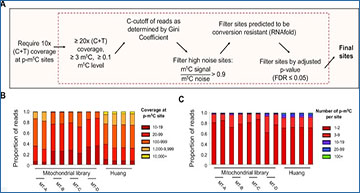The presence of 5-methylcytosine (m5C) in RNA molecules has been known for decades and its importance in regulating RNA metabolism has gradually become appreciated. Despite recent advances made in the functional and mechanistic understanding of RNA m5C modifications, the detection and quantification of methylated RNA remains a challenge.
Virginia Tech researchers compared four library construction procedures for RNA bisulfite sequencing and implemented an analytical pipeline to assess the key parameters in the process of m5C calling. They found that RNA fragmentation after bisulfite conversion increased the yield significantly, and an additional high temperature treatment improved bisulfite conversion efficiency especially for sequence reads mapped to the mitochondrial transcriptome. Using Unique Molecular Identifiers (UMIs), the researchers observed that PCR favors the amplification of unmethylated templates. The low sequencing quality of bisulfite-converted bases is a major contributor to the methylation artifacts. In addition, they found that mitochondrial transcripts are frequently resistant to bisulfite conversion and no p-m5C sites with high confidence could be identified on mitochondrial mRNAs. Taken together, this study reveals the various sources of artifacts in RNA bisulfite sequencing data and provides an improved experimental procedure together with analytical methodology.
RNA library constructed in this study
Fragmentation timing, bisulfite conversion conditions, and primers used in RNA BS-seq libraries are described as individual conditions. ‘ACT’ denotes the use of ACT primers rather than random primers.
Johnson Z, Xu X, Pacholec C, Xie H. (2022) Systematic evaluation of parameters in RNA bisulfite sequencing data generation and analysis. NAR Genom Bioinform 4(2):lqac045. [article]





